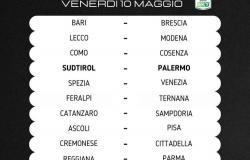
To accompany you in reading this interview I recommend the song Never give up, by Sia, contained in playlist “Asti pride” on Spotify
I haven’t yet understood what time is, but I’m certainly learning, by forced march, what its value is.
Learn to live in the moments, instead of counting the months. Understand that you have enough time, in this life, to put everything you want on the ground, everything that strictly depends on each of us. A great spiritual exercise, just as the chat with was magical Marco Guarinowho knows a lot about time.
50 years old, owner of “Marc & Darnò”is the only Italian to build wristwatches with astronomical complications, at an artisanal level.
I didn’t know his story, I discovered it by chance. I’m enchanted by it.
Marco, what relationship do you have with the Asti area?
I was born in Chieri and I started going to Asti more than 25 years ago, because on Saturdays we were here with friends for walks and aperitifs. I always thought that in the future I would like to live in Asti and, as soon as I had the chance, I made this wish come true. So my wife and I settled in this city on July 14, 2007.
Since you have lived here, do you think the area is valued enough?
I believe that there is a lot of potential, but unfortunately too little is still being done to make the area known. I’ll give you a recent example. Last week I was in Geneva, in the setting of a large exhibition of independent watchmakers. There were people from all over the world. Many people, interested in my story, asked me where I came from and in which city I had my laboratory. When I talked about Asti everyone fell from the clouds. Total darkness, so I try to explain Asti starting from its proximity to Turin. Imagine that an American knew Alba and not Asti.
I think it is a very courageous choice to keep your laboratory in Asti. I err?
Absolutely not. Honestly, it would be more convenient for me to move to Switzerland, to produce and sell directly there. Firstly because the industrial fabric of this type in Italy is not developed, especially in Asti, obviously. At a national level, there is micromechanics, but there are not the right tools for making watchmaking. The fact is that I care very much about Asti, sincerely, and I never miss an opportunity to make it known around the world, every time I travel for my work. Knowing that, for many, Asti is a stain in Piedmont hurts. I would do anything for this city and, in my own small way, I try every time I have the chance.
How did your passion for this discipline arise?
Since I was a child. I would like to say that, unlike many of my Swiss colleagues, I do not have a watchmaking background, nor has anyone in my family ever had one, just as I have not had an academic education and a ‘traditional’ path. I started completely self-taught, for a very practical reason. I loved certain watches, but couldn’t afford them. And then I tried to understand how to build them. The features that I liked were often found in very expensive watches, costing 300/500 thousand francs.
Can you tell me the main stages of your professional growth path?
After finishing high school I discovered that there was a watchmaking school in Turin. I then attended evening courses for three years. Being extremely difficult as a discipline, I had to learn this job: the school gives you a sort of basic knowledge of how to replace parts or how to look for defects in a product, but as far as construction is concerned it doesn’t provide the same preparation. . I had to learn that one myself. I also had to purchase special machines and tools to do this type of work, as I make the components myself, which are very small. I usually work with components that have a diameter of less than a millimeter. And then I was lucky enough to come into contact with the Academy of Independent Watchmakers in Geneva, the most famous group in the world in the sector. To date, 33 watchmakers are members, mostly Swiss, but there are also three Chinese, two Japanese, some French, and an Italian, who builds wall clocks and clocks. As for the wristwatch sector, however, there was no one. I met the founder of the Academy three years ago and he asked me to send him material about what I did. From that moment the project started and two people decided to support my candidacy within this reality (you need two people who are already inside the Academy to let you in). To date I have been carrying on this profession for about 15 years.
And what position do you currently occupy within this exclusive Academy?
I went from applicant to candidate. And soon I will have to take my work to a further step. The next project to present is the creation of a complete watch, i.e. astronomical complication and movement completely made by me. If so, I would be the only one in Italy to achieve this goal. Furthermore, next year the Academy will turn 40 and my story will be contained in the book they will publish. An honor, a great pride.
The most challenging watch made so far?
A clock with the equation of time. All watches with this complication use the Central European meridian as a reference, which ideally passes over Etna. The Sun, arriving from the east, has a certain value when it passes over Etna and all clocks thus take it as a reference (solar time of transit). The client asked me to build it in a special way, which could indicate the transit of the Sun over his house. So I had to do some important calculations, associating the equation of time with the local constant (i.e. the differences in degrees between the meridian of Central Europe and his home meridian). Every day of the year indicates the passage of the Sun above his head, essentially. Furthermore, there was then also a moon phase with an error of one day in 256 thousand years. A very important project, this, which took me more than three years of work.
Any other major projects you’re working on?
Currently I can mention the work commissioned by a group of Indians passionate about this sector. No one has ever built a clock related to their calendar, the Indian one, and they commissioned me to do this project which I am completing. I started it a year and a half ago and I’m finishing it.
What are the main phases of a project?
It all starts with the mathematical calculations underlying each creation. The data must not be too approximate. The objective is to ensure that the mechanical ratio of the wheels is as close as possible to the astronomical one. After that, I create a prototype and when it is working I continue with the work, building the final product.
I imagine your clientele is not from Asti…
No, no customers from Asti. 90% are foreigners, distributed mainly between America and Asia. Something in Europe, but very few Italians.
Yours is definitely not a conventional story. What advice would you give to kids looking for themselves?
Let me start by saying that I have three children and that none of them, to date, are interested in doing what I do. I have always told them to follow their desires and to somehow build healthy expectations. I recommend planning, even if I understand that it is not easy, from the beginning a career that can be work, school, without ever stopping looking around. In this world we don’t just need lawyers or doctors. Mine is a niche job, but I’m the only one in Italy who does this and I would like to have someone who could give me a hand, but it’s impossible because there is no training on this. I would like to find someone interested in my work, but I can’t afford to train them, possibly. I produce 10/15 watches a year (depending on the complexity) and for three years already, from 2022 to 2025, I am full, with complete orders. It is not possible for me to train anyone. There are little-considered activities and schools that could give a lot to kids. I tell my children that there is only one life and that we need to do what we really like to fulfill ourselves. To get to the end and say you lived the way you wanted. For me it’s not a burden to get up in the morning and go to the laboratory and work 14 consecutive hours, because what I do is the best job in the world.
Were there difficult moments when you thought about giving up?
Yes, I sometimes thought I couldn’t do it. Especially when you have an important project in front of you, you accept it as a challenge and then there are difficulties linked to not being able to compare myself with other builders. Everything I do I have to invent and I don’t have feedback from anyone in the profession. Disappointment comes, but by dint of thinking and trying you get it right. Every now and then I lose my patience, it often becomes stressful. I work with objects so small that precision is fundamental, nothing can be done by leaps and bounds, I work with microns, hundredths of a millimetre. I use all manual machines, for watchmaking but manual, while most of my colleagues instead use parts made outside, by other companies, therefore perfect pieces, all the same. Each of my watches is a unique piece, despite perhaps making series of 25, because you notice the differences, as the components are handmade. Each watch, we can say, has a soul of its own. There’s no denying that the economic aspect is important, but it excites me to know that what I created ends up on the other side of the world, that it is appreciated. It fills my heart with pride, it gives me more joy than thinking about the money I will receive in return.
A motto you identify with?
“Never give up, because you could be one step away from success.” When things don’t work out for me – and it happens – maybe I work for hours on a piece and then I get everything wrong, I think about this and I manage to move forward. I also tell my children this. And then “perseverance is opportunity”.
The beyond, a place not for everyone
I find the exchange with Marco beautiful, I think we speak the same language. His story gives me many ideas to reflect on, including the fact that, too often, we allow ourselves to be overcome by discouragement. He feels incapable, inadequate, out of place. He gets lost in the time trap. Marco, through his words, teaches us to look forward, to go beyond, beyond everything and everyone.
And, as we know, the beyond is not a place for just anyone.
Greetings to the readers of Orgoglio Astigiano
Do you want to stay updated on the Stories of Asti Pride?
Take part in the event on November 14th at Teatro Alfieri, gli “THE GENERAL STATES OF ASTIGIAN PRIDE”!
Orgoglio Astigiano is a project that aims to bring to light stories of life and talents of the area, which finds its space in the weekly column “Stories of Orgoglio Astigiano”, edited by the journalist Elisabetta Testa.





